In World War II, nursing became a prominent aspect when fighting the war. Before this war, women weren’t even considered to be allowed to enlist in the army; but as you will see in the following information, it changed drastically during this time period. Women were given more opportunities than they had ever had before. Nursing in the World War II era truly gave women the respect they deserved in the military and back on the homefront. Within the military during this time women go to experience new and improved things like; the WAC, WAVES, and being involved in the Army Nurse Corps. These three things justified everything nurses did in World War II and helped the growth of military nurses grow even more than they already has after World War I.
Army Nurse Corps
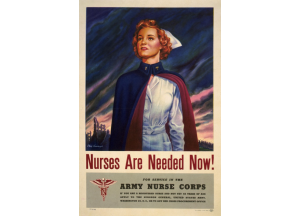
Army Recruiting poster, “Nurses Are Needed Now!… ” by Stu L. Savage, 1944, Prints and Photographs Division, Library of Congress.
At the time, nurses had helped in previous wars but there was never a drastic need for them until World War II. The Army Nurse Corps consisted of over 50,000 nurses by the time the United States was in the middle of the war. When the Japanese bombed Pearl Harbor on December 7th, 1941 there only 82 military nurse on duty. This showed the military that they were in desperate need for more nurses, which meant that the population of the Army Nurse Corps would grow drastically within the next few years. The addition to the Army Nurse Corps, however, caused civilian nurses to go scarce. The warfront was so desperately in need that majority of the nurses on the homefront took themselves to the warfront to help the dying soldiers. This left the homefront scarce, which caused another drastic change in nursing and nursing education. In 1943, Congress passed the Bolton Act which ended up creating the Cadet Nursing Corps.5 This granted nursing student who were still receiving their education the right to engage in serving the war front and civilians during the duration of the war. Despite the intense need for nurses, there were still a limited amount of African American nurses who served in World War II. The Army Nurse Corps did not accept a lot of African American nurses because they believed that they were only allowed to care for African American soldiers in African American hospitals. This caused the number of African American nurses to dwindle down to 160 by 1943 because of the limitations set by the Army.1
In a newspaper article from 1945, an African American nurse recounts her experiences and happenings as a nurse during World War II:
“They classified us,” Burrell said. “They were not going to take us in until Mrs. Roosevelt, African American educator Mary Mcleod Bethune and Mrs. Stauplers, a president of now-defunct African American nurses association, demanded the surgeon general accept black nurses.”6
Mildred Helen McAfee
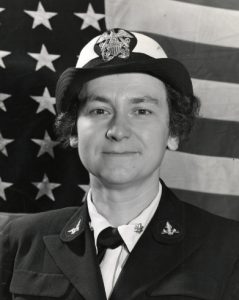
McAfee in her uniform for the Naval Reserve, Vassar College Archives and Special Collections.
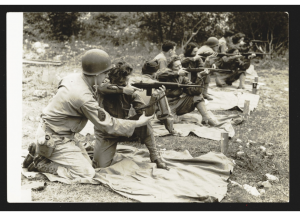
WAC photographs, Planet News Ltd., collection of Edith G. Wells, Veterans History Project, American Folklife Center, Library of Congress.
Mildred Helen McAfee was the President of Wellesley College in 1936 before she entered the war as a nurse. Once the war started, she took a leave of absence from her position at the college and became the Navy’s first female line officer; she was eventually commision as a Lieutenant Commander in the Naval Reserve.4 Along with this position, she also helped grow a legislation passed by Congress called WAVES. This acronym stood for Women Accepted for Volunteer Emergency Service and McAfee was the first ever director of it. WAVES was a collection of more than 80,000 nurses who specialized in different occupations and helped in the war effort alongside the Navy. Eleanor Roosevelt was an avid supporter of the creation of this Unit of the Navy Reserve and was persistent in her fight to make it official. Eventually, in 1942 on July 30th, WAVES was passed by Congress and signed into law by President Franklin Roosevelt; this gave the U.S. the right to accept women into the Naval Reserve. Mildred McAfee guided this program until 1946, after she married Reverend Dr. Douglas and returned to her Presidency at Wellesley College where she eventually passed away in 1994.
WAC
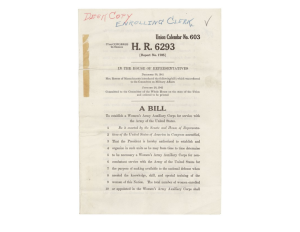
HR 6293, A bill to establish a Women’s Army Auxiliary Corps, January 28, 1942, Records of the U.S. House of Representatives, National Archives and Records Administration.
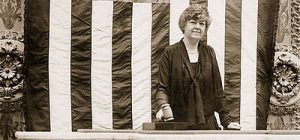
Edith Nourse Rogers of Massachusetts presides over the House Chamber in this image from 1926, Collection of the U.S. House of Representatives.
WAC stand for the Women’s Army Corps, which had over 150,000 American women within it and was created after the Women’s Army Auxiliary Corps in 1943. As stated in the Women’s Army Corps book written by Judith Bellagraire, “Both the Army and the American public had difficulty accepting the concept of women in uniform”. Bellagraire wanted to explain the pressures of women in the war at this time as well as the maturity level of those in America at that time.2 The creator of the Women’s Army Auxiliary Corps and the Women’s Army Corps was a woman named Edith Nourse Rogers, who is one of the key players in the aspect of nursing in World War II. She was the first congresswoman from New England to be appointed to the Committee on Veteran Affairs in which she was the chairman for the 80th and 83rd Congress. After this string of her life, she eventually introduced the legislation that would be passed in March of 1942 and that would create the Women’s Army Auxiliary Corps and the Women’s Army Corps.7
In the newspaper article titled What a Day it Was!, women veterans discuss the effects of being involved in the WAC, WAVES, and the changes made between WWI and WWII:
“When I served, women didn’t have the right to vote,” says Annie Pederson Freeman, a 94 year old WWI yeoman.6
In conclusion, all of the programs explained in my sub-topic page helped push America to become more content with nurses as a whole and the concept of them being in the military. The programs explained also aided in World War II immensely, and the outcome of the war would not be the same if women had not earned their rights in the military and the war. WAC/WAAC and WAVES helped grant women the same rights as men when enlisting in the military, the Army Nurse Corps expanded into something much larger than it had been before the war, and nurses were finally recognized for the feats they achieved in World War II.
- U.S. Army Center of Military History . The Army Nurse Corps. CreateSpace Publishing 2014.
https://history.army.mil/books/wwii/72-14/72-14.HTM. - Bernier, Francie. 2013. “‘We Did the Best We Could’ – The United States Army Nurses Of Ie
Shima.” Urologic Nursing 33 (2): 79–102. doi:10.7257/1053-816X. 2013.33.2.79. - Bellafaire, Judith A. “The Women’s Army Corps: A Commemoration of World War Ll Service .”
In The Army Nurse Corps, 32–50. CreateSpace Publishing 2014. - U.S. Navy . “McAfee, Mildred (H).” Naval History and Heritage Command n.d.
https://www.history.navy.mil/our-collections/photography/us-people/m/mcafee-mildred-h-horton.html. - Vaught , Wilma L. “What a Day It Was!” The Stars and Stripes , January 11945.
http://www.legendsofflightnurses.org/Uploads/Newspapers/NewspaperArticles/Stars_and_Stripes_1995.pdf. - “Women in the Military: World War II.” U.S. Capitol Visitor Center https://www.visitthecapitol.gov/exhibitions/artifact/hr-6293-bill-establish-womens-army-auxiliary-corps-january-28-1942
- History, Art & Archives, U.S. House of Representatives, “ROGERS, Edith Nourse,” https://history.house.gov/People/Detail/20569 (October 30, 2018)